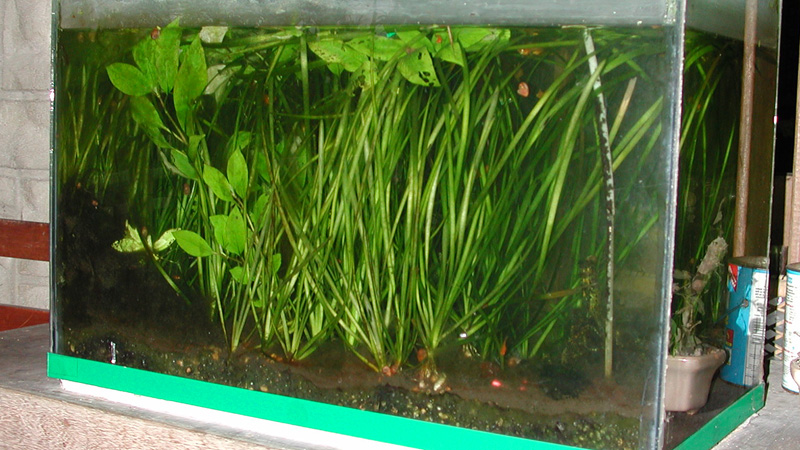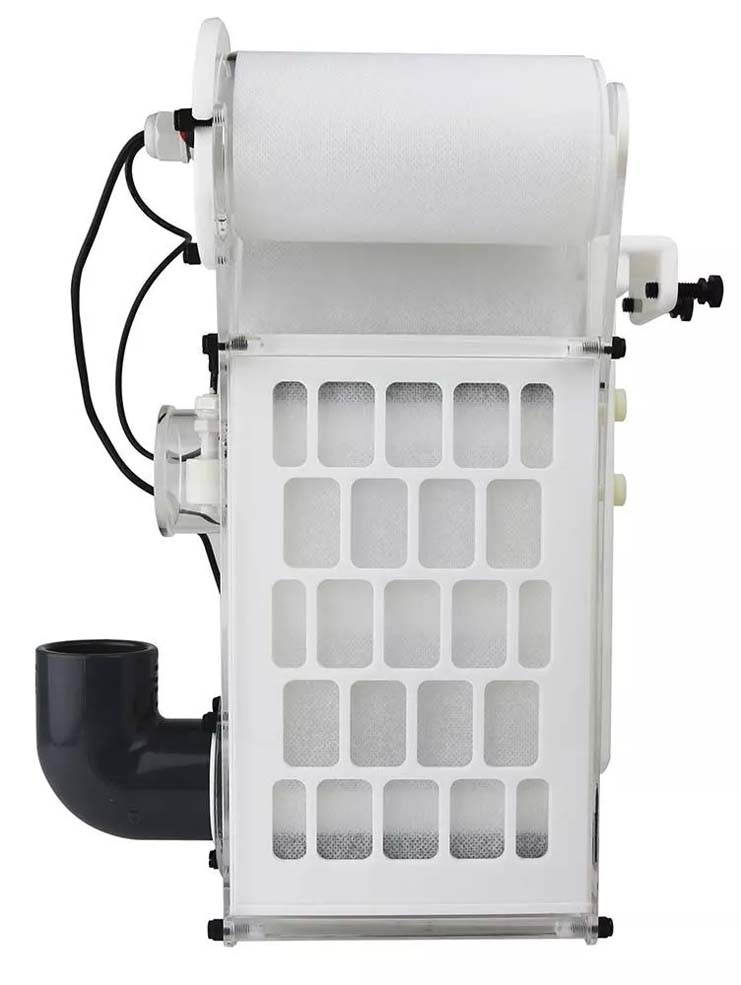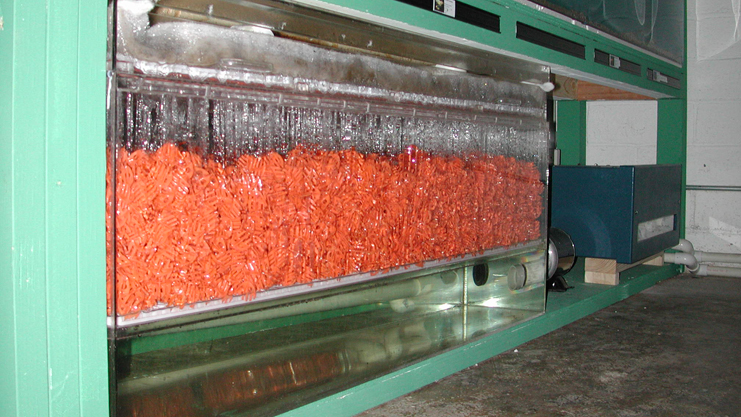Filtration and Current
Aquarium hobbyists keep animals and plants from many biotopes. Ecosystems' physical and chemical diversity can make freshwater even more challenging than marine aquariums. Some fish and plants prosper in stagnant pools of water, while others prefer fast-flowing waters. Inquiring where plants and fish thrive in the wild will help hobbyists decide which are best suited for their system. Trying to duplicate similar conditions in the aquarium will help ensure success.
Hobbyists should consider the biotope where aquatic plants and fish thrive when selecting filtration systems. Some aquatic plants (Nymphaea spp. [lilies], Nelumbo spp. [lotus]) and fish (gouramis, betta) prefer minimal current, while others thrive in strong current.
How much current the filtration system produces should be the highest priority when evaluating units for your aquarium. The hourly turnover rate (gallons or liters per hour) is not a good indicator of how much current the filtration system will produce. If the fish and plants in the system prefer a lot of current, look for systems that can provide strong surface agitation and current.
Some current, in most cases, should be provided in the aquarium, even for fish and plants that like stagnant water. Aquarium lights will transfer heat into the surface of the water. If the aquarium is stagnant, the top few inches can easily become 10º F (6º C) warmer than the bottom few inches. Current is created in small pools of water in nature when the wind blows.
Hobbyists should minimize the air bubbles in the return from the filter. Bubbles in the water column pop at the surface, spraying water microdroplets. When the microdroplets evaporate, they leave mineral deposits on the glass and equipment.
Sump, canister, and some internal power filters can produce strong surface agitation and current.
Sump filters are the easiest to clean and provide the best gas exchange.
Canister filters are often time-consuming to clean, and it can be difficult to seal the lid after a few years. Because maintenance of canister filters can be problematic, many hobbyists do not clean them as often as they should.
Internal power filters are easy to clean, and there is no concern about leaking.
Hang-on-the-back (HOB) filters that use gravity return create less current and are good options for plants and fish that do not like a lot of current. Bubbles are created when the water is returned to the aquarium from HOB filters. Mineral deposits are common in systems that use HOB filtration systems.
Wavemakers, power heads, and submersible pumps can add additional current. Current can help keep detritus in suspension so the filter intake can collect the particles.

A filter is not required to have a thriving planted aquarium. The filter is to see the fish and plants clearly and to keep detritus from settling on the bottom.
A system with no filter recycles the organic carbon stored in detritus into inorganic carbon, which can be used by aquatic plants. Systems without filtration will have detritus settle on the bottom, where it becomes dissolved organic carbon, which supports a thriving microbial ecosystem. This mulm on the bottom of the system will provide natural CO2 and can remove elements (metals) from the water column. This biologically active mulm is a way to deliver nutrients to plant roots.
Whether detritus is located in the display or the filter, it is still in the system. Detritus collected in the filter will be broken down by heterotrophic and autotrophic bacteria and archaea, adding to nitrate production.
Hobbyists remove detritus from the system with a water change and filter cleaning. Hobbyists can reduce how fast nitrate accumulates in the system with frequent filter cleaning.
Many of the filtration systems marketed to hobbyists today are based on trends from the 1980s and early 1990s, which included adding as much media as possible for biological filtration. In the middle 1990s, advanced hobbyists shifted away from biological filtration in the filter.
The advanced hobbyists removed the biological media from the filter and let the biological filtration happen within the display. This shift in filtration practice solved the issue of ammonia and nitrite spikes a few days after cleaning. This change forces the substrate to be more heavily colonized by nitrifying bacteria and archaea. With newly created nitrate closer to the anoxic layer, denitrification can happen either by plant roots or anaerobic bacteria.
Most sump filtration systems produced now only use filtration socks for mechanical filtration. Roller mat systems are gaining popularity as sump filtration systems for their less frequent maintenance and the fact they can remove detritus from the system before it decays. Many do-it-yourself plans for sump systems make it a relatively cost-effective option for aquariums.
Significant amounts of beneficial bacteria and archaea can be lost when cleaning media. Many hobbyists suggest using aquarium water to clean the media, but beneficial bacteria and archaea will be lost even with this method.
Using chlorinated tap water to spray off media and quickly returning to dechlorinated water will not affect the remaining beneficial bacteria and archaea. Chlorine must have contact time to kill bacteria and archaea, and the short time it takes to clean media is not long enough to kill microbes[45].
Three types of filtration aquarium hobbyists commonly use:

Mechanical filtration removes detritus from the water column. Sponge, filter felt, fleece, and polyester fiber is the most common media used for mechanical filtration.
Mechanical filtration media is often heavily colonized by heterotrophic bacteria and archaea, which help process fine particles of food not eaten by animals, solid waste, and decaying plant matter. Heterotrophic bacteria and archaea create a slimy coating on dirty filter media. Biosolids serve as a substrate for heterotrophic bacterial and archaea growth, an increase in their concentration will eventually result in increased oxygen consumption, poor biofilter performance[46], increased water turbidity, and even mechanical blockage of parts of the system.
Cleaning mechanical filtration media frequently can reduce how fast nutrients accumulate in the system.

Hobbyists can use chemical filtration to remove undesirable or excessive chemicals, tannins, and medications from the water column. Chemical filtration does not technically remove chemicals from the system, it binds them to the media.
Chemical filtration can remove chelated nutrients (iron-EDDHA) from solution[71].
Chemical filtration media can be exhausted quickly, which then becomes biological media. For chemical filtration media to be most effective, it should be placed in a high-flow area and removed after a few days of use.
Regular chemical filtration is unnecessary, and many hobbyists do not use it except for a specific short-term purpose.
Activated Carbon
The most common form of chemical filtration used in the hobby is activated carbon. Activated carbon can remove tannins, chlorine, and medication from the water. There is a myth in the aquarium hobby that it causes hole in the head/head and lateral line erosion (HITH/HLLE) disease. Carbon as the cause of HITH/HLLE disease has been disproven. Hobbyists have been using activated carbon in their systems for decades and have proven it safe. Many filter manufacturers include activated carbon in the filtration media.
Synthetic Resins
Several manufacturers also market synthetic resins for chemical filtration that can be recharged with household bleach (sodium hypochlorite [NaClO]). The bleach is then neutralized with sodium thiosulfate.
Some resins are designed to remove GH from the water and can be recharged with sodium chloride (salt). GH-reducing resins exchange sodium for magnesium and calcium. Magnesium and calcium are beneficial macronutrients for plants, and the concentration in most tap water benefits most aquarium fish. The preferred method to reduce GH in aquatic systems is to change the water with RO or distilled water.
Zeolite
Zeolite is sometimes used to bind ammonia in freshwater systems and can be recharged with salt (sodium chloride). Zeolite uses ion exchange to remove ammonia, which releases sodium. Because zeolite releases sodium, it is not recommended for planted aquariums.
Granular Ferric Oxide
Granular Ferric Oxide (GFO) removes phosphate. GFO should not be used in new aquariums while establishing a mature nitrogen cycle since nitrifying bacteria and plants need phosphate. GFO is sometimes used when excessive phosphate (above 1 ppm) is detected and there is an excessive algae issue.
The bacteria and archaea that oxidize ammonia and nitrite into nitrate colonize all the surface area in a system in constant contact with the oxygen-rich water column. Many aquarium filter manufacturers incorporate some form of material in the filter design that nitrifying bacteria can colonize.

Filtration systems that include biological filtration media can adversely affect the aquarium after thoroughly cleaning. Since materials used in filters for biological filtration are in high-flow areas, they can become heavily colonized by autotrophic and heterotrophic bacteria. Cleaning filters can cause significant amounts of autotrophic and heterotrophic bacteria to be washed away.
When power is lost for an extended period, chemolithoautotrophs (nitrifying bacteria) can go dormant to survive without oxygen for an extended period. The heterotrophic bacteria in filters can quickly use up the oxygen in the surrounding water and then start to die. A significant portion of the ecosystem's heterotrophic bacteria can be lost during a power outage. A filter will turn anoxic without oxygen, and an obvious sign of this is the smell of hydrogen sulfide (rotten eggs).
An extended power outage can result in significant new dead organics, which can cause ammonia and or nitrite to spike a few days later. If an extended power outage happens, the filter should be cleaned to minimize the amount of detritus and dead heterotrophic bacteria.
The nitrification of ammonia and nitrite takes place in a thin biofilm layer that is only 100 microns thick. When hobbyists allow the biological media in the filtration system to become covered with a thick slimy heterotrophic layer, the effectiveness of the media for nitrification is severely degraded[47].
In fish hatcheries, it is common to see trickle filtration systems with towers filled with bio-media. The bio-media supports high fish stocking densities in fish hatcheries, where tanks are kept bare for easy maintenance and have minimal surface area for nitrifying bacteria to colonize.
For most aquarium systems, it is best to have the biological filtration occur in the aquarium, not the filter. This practice will help minimize the loss of heterotrophic bacteria during a power outage.